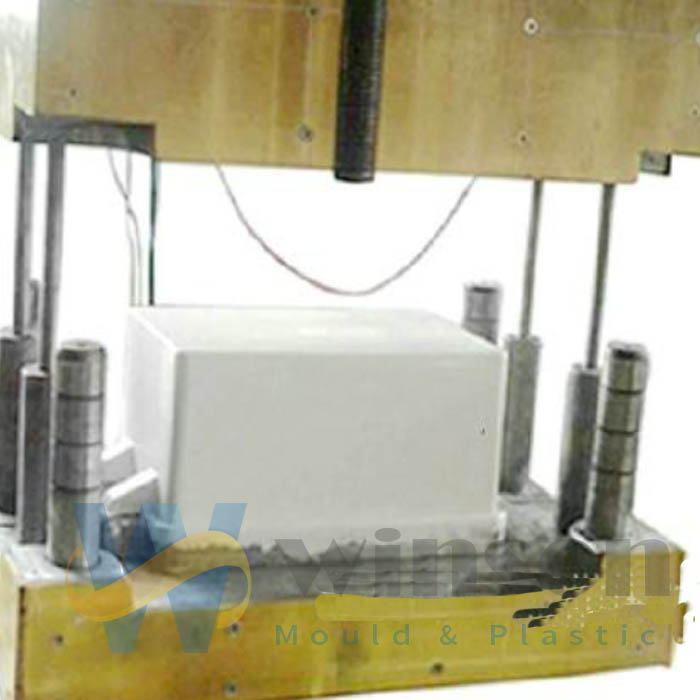Overview of the Compression Molding Process.What are the steps of compression molding mould process? There has 8 main steps in the compression molding process of thermoset composites as follows:
Table of Contents
Toggle
Schematic diagram of compression molding machine using composite material
1. Install Compression Molding Mold
Install the pre-produced metal compression mold on the four-column hydraulic press,and then heat the mold to 130 degrees Celsius-150 degrees Celsius(According to the specific product thickness and type of materials,this temperature is situable for most product).
2. Feed Material into Compression Molding Mold
After the compression mold is heated to a suitable temperature,use a temperature probe to check the temperature of the core and cavity mold,then feed thermosetting or thermoplastic materials into the mold cavity.
3. Close Compression Molding Mold
Close the compression mold core and cavity after feeding. When closing the mold,the speed is fast first,and then the speed is changed to the slow speed when the core and the cavity are in quick contact.The quick first and slow operation method is beneficial to shorten the non-production time,prevent the mold from scratching, and avoid the raw material in the mold cavity from being carried out by the air due to the rapid closing of the mold,and even the displacement of the insert and the destruction of the molding rod.After mold was closed,we can be increased pressure to heat and pressurize of raw materials.
4. Exhaust Compression Molding Mold
Moisture and low-molecular substances are often released when molding thermosetting plastics.In order to eliminate these low-molecular substances,volatiles and air in the mold, the pressure can be relieved after the plastic reaction in the plastic mold cavity has progressed to a suitable time Loose mold exhaust for a short time.Exhaust operation can shorten the curing time and improve the physical and mechanical properties of the product, and avoid stratification and bubbles inside the product;but too early,or too late will not work,too early to achieve the purpose of exhaust ,if too late, because the material surface is already curing, gas cannot be discharged.
5. Curing Composites Materials
The curing of thermosetting plastics is to keep it under the molding temperature for a period of time,so that the polycondensation reaction of the resin reaches the required degree of cross-linking,and make the product has the required physical and mechanical properties.Plastics with a low curing rate can also be cured when the product can be completely demolded,and then post-processing to complete the entire curing process; in order to improve the utilization rate of the equipment.The molding curing time is usually the holding pressure’s time, generally,it ranges from 30 seconds to a few minutes and most of them doesn’t exceed 30 minutes.Too long or too short curing time has an impact on the performance of the product.
6. Demoulding
Demoulding is usually done by ejector rods. Products with molding rods or some inserts should be removed first with special tools, and then demolded.
7. Compression Mold blowing and clean
After demolding, the compression mold cavity and mold surface are usually blown with compressed air. If the fixation on the mold is tight, it can be cleaned with a copper knife or a copper brush, or even a polishing agent brush, etc.
8. Post-treatment Composite Products
In order to further improve the quality of products,thermosetting plastic products are often post-treated at a higher temperature after demolding. Post-treatment can make the plastic curing very well and reduce or eliminate the internal stress of product,reduce the moisture and volatile matter in the product etc.,which is beneficial to improve the electrical performance and strength of the product.
The compression molding mold process uses the characteristics of each stage in the resin curing reaction to realize product molding, that is, the molding material is plasticized, flows and fills the mold cavity, and the resin is cured. During the flow process of the molding material filling the mold cavity, not only the resin flows, but also the reinforcing material flows with it. Therefore, the molding pressure of the compression molding process is higher than that of other processes, which belongs to high-pressure molding. Therefore, it requires not only a hydraulic press that can control the pressure, but also a high-strength, high-precision, high-temperature-resistant metal mold.




